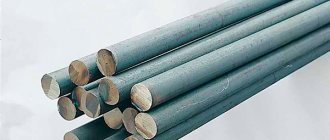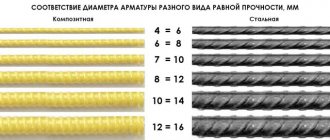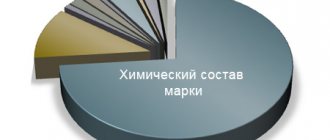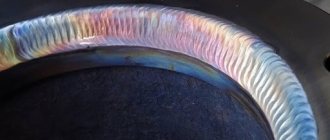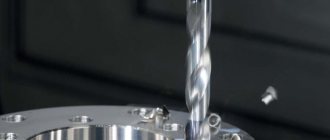Ferritic steel
Some types of carbon and low-alloy steels belong to the ferritic class. The alloy composition includes chromium, vanadium, molybdenum, silicon, and other chemical elements. Due to the protective layer of chromium, the products are resistant to aggressive acid-base environments.
Ferritic steels have a crystalline structure. The main component is a cubic cell with an atom in the center. The grain type of structure is relevant for alpha iron and becomes an indispensable condition for imparting magnetic properties to ferritic steel.
Properties and advantages of ferritic steels
Despite the fact that the ferritic class of steel does not have high strength, thanks to heat treatment, unique physical and chemical properties are achieved that are not inherent in other types of metal. The presence of alloying components makes such products resistant to corrosion for decades. The insignificant content of chromium, magnesium, and other additives reduces the cost of rental, so the price of the products is much lower than that of competing products.
Among the advantages of ferritic steel it is worth noting:
•plastic;
•light weight;
•ease of processing;
•long service life (from 10 years);
•sensitization only at thermal conditions above 925°C.
After acquiring anti-corrosion properties, ferrite is not much inferior in strength characteristics to ordinary steel. Even if rust does occur on such products, it is localized, and metal oxidation is associated with damage to the protective coating.
Weldability
Ferritic steels
Main problems:
1) grain growth in the HAZ and embrittlement; subsequent heat treatment does not refine the grain and does not eliminate brittleness; 2) development of intergranular corrosion (ICC) during rapid cooling from a temperature of T 900°C; MCC can be eliminated by tempering at T = 650 – 900°C or by bonding carbon into niobium or titanium carbides; 3) embrittlement in the HAZ at elevated temperatures is caused by the formation of the σ-phase (Fe-Cr intermetallic compound) in the temperature range T = 650 - 850°C and the development of 475°C brittleness in the range T = 450 - 525°C.
These phenomena intensify with increasing chromium content in steel; 475°С - brittleness is eliminated by hardening from T = 700 - 800°C, and brittleness from the σ - phase is eliminated by annealing at T > 900°C.
Austenitic steels
Main problems:
1) the formation of hot cracks in the weld and heat-affected zone is caused by:
a) coarse-crystalline and different-grained (stitched) structure; b) the formation of low-melting eutectics and segregation of impurities; c) the presence of alloying elements that cause the formation of cracks (Si, Ti, Al, B, etc.); d) the presence of low-melting impurities Pb, Sn, Bi, as well as S and P.
The main way to prevent hot cracks is to refine the structure in the weld due to the release of high-temperature phases of δ-ferrite in the austenite of the weld, high-temperature carbides, carbonitrides, and boride eutectic.
2) development of MCC in the HAZ during heating in the range T = 650 - 750°C due to the formation of chromium carbides and a decrease in its content along grain boundaries below 13%;
3) embrittlement during the formation of the σ-phase in the range T = 650 - 750°C, when the steel contains ferrite.
Ferritic stainless steel: types
GOST 5632-2014 is used to classify ferritic metals. It replaced GOST 5632-72, which was developed back in Soviet times. The designated standard applies to deformable steels produced on an iron-nickel and nickel base. These metals are designed for corrosive environments.
Based on the main characteristics of the alloys, these materials are classified into groups:
- corrosion-resistant (stainless) – alloys with high resistance to various types of rust;
- heat-resistant – alloys with high resistance to chemical degradation of the surface at thermal conditions above 550 °C;
- heat-resistant - alloys that can retain their properties at high thermal conditions.
According to the steel structure factor, in accordance with GOST 5632-2014, martensitic, martensitic-ferritic, ferritic, austenitic-ferritic, austenitic-martensitic, austenitic steels are distinguished. In the CIS, marking of stainless metals is carried out using an alphanumeric combination. The letters encode the chemical elements and smelting options, and the numbers indicate the number of chemical elements.
In addition to GOST, there is a generally accepted classification of stainless steels according to the AISI (American Iron and Steel Institute) standard. This product marking is used primarily in the metal markets of the USA and Europe. There are three classes: 200th, 300th, 400th. For ferrites, the 400 series is provided.
Depending on the component composition of ferritic steel, there are 5 types of metals of the 400 series:
- 430;
- 409/410 L;
- 430 Ti, 439, 441;
- 434, 436, 444;
- 446, 445, 447.
The first of the listed groups (grade 430) is the most common. The structure contains a high chromium content, so it is extremely resistant to aggressive acid-base influences. This grade of steel is suitable as an inexpensive replacement for austenitic types.
Ferritic 409/410 L stainless steel contains minimal chromium. The metal is used in environments where exposure to acid-base conditions is minimal. Usually these are living conditions with a comfortable temperature regime, the absence of sudden thermal changes, and a low level of humidity.
Grades 430 Ti, 439, 441 have plasticity, which facilitates the process of welding and processing (cutting, bending, etc.). The products can withstand harsh operating conditions, in particular at low temperatures, high humidity levels, and constant ultraviolet radiation.
Products of grades 434, 436, 444 contain a significant amount of molybdenum, which increases its corrosion resistance. Such products have a special purpose. They are used in industrial environments where strength, lightness, and durability of the metal are required. For example, grade 444 has a wear resistance index (PRE) comparable to heavier grades of steel (such as grade 316), making it suitable for use in moving machinery.
Grades 446, 445, 447 belong to the category of special-purpose ferrites. There is a maximum percentage of chromium present here, so such products are not subject to corrosion. Maximum acid resistance has made this class the most popular, but also significantly increased its cost. The corrosion resistance of grade 447 is identical to that of titanium. Sometimes molybdenum is added to this type of metal along with chromium to impart strength characteristics.
Central applications
The possibilities described above explained the wide range of applications of ferritic steels. Depending on the specific grade of steel, it can be used to create parts for high-temperature equipment and internal elements of chemical apparatus. An equally significant area of use is the creation of pyrolysis coils, as well as various types of containers and containers.
Usage is determined by analyzing the technical characteristics of a particular brand. To give the reader a better understanding of these mechanical properties, we have collected them in a separate table below:
Table 2. Chromium ferritic steels: mechanical properties, no less.
| steel grade | σв, MPa | σ0.2,MPa | δ5, % | ψ,% | KCU, J/cm 2 | Examples of using |
| 08Х13 | 590 | 410 | 20 | 60 | 10 | Internal devices of chemical apparatus |
| 08Х17Т | 372 | — | 17 | — | — | |
| 08Х23С2У | 490 | 10 | 60 | Pyrolysis coils | ||
| 04Х14Т3Р1Ф | 500 | 320 | 15 | 20 | 10 | Nuclear fuel racks, containers |
| EP 882-VI | 372 | 245 | 22 | — | 60 | Substitute for Cr-Ni austenitic steels |
| EP 904-VI | 440 | 323 | 24 | High temperature equipment parts | ||
| 15Х25Т | — | 14 | 20 | Internal devices of chemical apparatus |
Scope of application
Ferritic stainless steel is a sought-after material used in numerous fields of human activity. Grade 430 is often found in the construction of household appliances, for example, washing machine drums, heating elements, kitchen sinks. Cutlery and door handles are also made from this steel. Brand 409/410 L refers to relatively inexpensive materials, as a result of which such metal is used by car manufacturers. Steel is included in the exhaust system and body parts of vehicles.
Grades 434, 436, 444 are used in various industrial structures. We are talking, for example, about tanks for hot liquids, solar heaters, heat exchangers. Sometimes this class of steel is used in microwave oven elements, electronic circuits, and LCD screens. As for ferritic steel grades 446, 445, 447, it is used in shipbuilding or the production of special-purpose products that are subject to severe corrosion.
The ferritic class of steel is a carbon and low-alloy material that has proven itself when used in aggressive acid-base environments. Products made from this metal have numerous advantages, which predetermined their popularity. They are used in various fields of human activity, including in the domestic and industrial spheres.
Heat treatment
Ferritic steels
Preheating 150 - 200°C is recommended for metal thickness more than 10 mm. The air temperature when welding ferritic steels should be not lower than 5°C for 08Х13, for others - not lower than 10°C.
Welded joints made of steel 08Х13 after welding, as a rule, are not subjected to heat treatment; those made of steels 08Х17 and 15Х25Т are subjected to tempering at 700 - 750 ° C with accelerated cooling (ICC warning) for products operating in corrosive environments.
Austenitic steels
Austenitic low-carbon steels, highly alloyed with chromium and nickel, are subjected to hardening to homogeneous austenite (austenization) - heating to a temperature of 1050 - 1100 ° C, holding for 1 - 2 hours and cooling in air, oil or water. Unlike carbon steels, these steels, after hardening, acquire increased ductility and impact strength.
Austenitic steels with a high carbon content and alloyed with Mo, W, Nb, Ti, Al, steels with carbide and intermetallic hardening are subjected to special heat treatment, austenitization (hardening) and aging (tempering).
To prevent MCC in welded joints, heating for two to three hours at a temperature of 850 - 900°C is recommended.
Corrosion resistance
The resistance to pitting corrosion of stainless steels is assessed by the equivalent PREN number.
PREN =% Cr + 3.3% Mo + 16% N, where the terms correspond to the mass % chromium, molybdenum and nitrogen content respectively in the steel.
Nickel plays no role in resistance to pitting corrosion, so ferritic stainless steels can be as resistant to this form of corrosion as austentitic grades.
In addition, ferritic grades are very resistant to stress corrosion cracking (SCC).
Characteristics and classification of stainless steel
To increase resistance to atmospheric corrosion, stainless steel manufacturers purposefully change its chemical composition. The addition of nickel, phosphorus, copper and other elements significantly changes the characteristics of steel. For example, enriching the alloy with a small amount of copper (from 0.2% to 0.4%) can increase the corrosion resistance of structures exposed to the industrial atmosphere by 20-30%.
According to the chemical composition, alloy steels are divided into:
- Chrome;
- Chromoniciliaceae;
- Chromium-manganese-nickel.
.
In turn, chromium steels are ferritic, semiferritic and martensitic. Chromium-nickel steels can be austenitic-carbide, austenitic, austenitic-martensitic and austenitic-ferritic.
Ferritic stainless steel
Ferrite-chromium stainless steel has high corrosion resistance in aqueous solutions of ammonia, nitric acid, a mixture of various acids (phosphoric, nitric, hydrofluoric), and ammonium nitrate. Ferritic alloy steel belongs to the 400 series.
Austenitic stainless steel
The main advantage of austenitic stainless steel is its high ductility and strength. Such steels have excellent corrosion resistance in almost all working environments. Alloy austenitic steel is mainly used as a structural material in most branches of mechanical engineering. In theory, structures made of austenitic steel do not exhibit magnetic properties. However, under special conditions, austenitic stainless steel can become magnetic (often after machining).
Austenitic-ferritic and austenitic-martensitic steel
Austenitic-ferritic stainless steel has a higher yield strength than single-phase austenitic steel, has good weldability and is not prone to grain growth. Austenitic-martensitic alloy steel has similar characteristics to austenitic-ferritic steel. This type of stainless steel is characterized by increased strength.
Chemical composition of several grades (main alloying elements)
Chemical composition (balance: Fe)
| AISI/ASTM | EN | Weight % | |
| Cr | Other items | ||
| 405 | 1.4000 | 12.0 — 14.0 | — |
| 409L | 1.4512 | 10.5 — 12.5 | 6 (C+N) |
| 410L | 1.4003 | 10.5 — 12.5 | 0,3 |
| 430 | 1.4016 | 16.0 — 18.0 | — |
| 439 | 1.4510 | 16.0 — 18.0 | 0.15 + 4 (C + N) |
| 430Ti | 1.4511 | 16.0 -18.0 | Ti: 0.6 |
| 441 | 1.4509 | 17.5 — 18.5 | 0.1 0.3 + 3C |
| 434 | 1.4113 | 16.0 — 18.0 | 0,9 |
| 436 | 1.4513 | 16.0 — 18.0 | 0,9 0,3 |
| 444 | 1.4521 | 17.0 — 20.0 | 1.8 0.15 + 4 (C + N) |
| 447 | 1.4592 | 28 — 30.0 | 3.5 0.15 + 4 (C + N) |
TD SpetsKomplekt
| 316(10Х17Н13М2Т) - Technical data | Steel AISI 310(20Х23Н18) |
| Steel AISI 430 | Steel 201(12X15G9ND) |
| Steel 40Х13 | Steel AISI 409 |
| Steel 15Х25Т | Steel AISI 420 |
| Steel AISI 410 | Steel AISI 439 |
Chrome steels.
Chromium stainless steels are the cheapest and therefore the most common. Minimum Cr content 13%. When the Cr content is more than 13%, the α phase (ferrite) stabilizes and no polymorphic transformations occur in such steels. Heating only causes the grain to increase. Long-term exposure at a temperature of about 600-650ºC causes the appearance of an intermetallic phase in steels. The formation of such a phase greatly embrittles the steel and is therefore undesirable. Slow cooling or prolonged exposure at 500ºC causes the formation of an ordered solid solution, which also causes brittleness of the steel. This fragility is called 475ºC fragility. An increase in temperature above 1000ºС causes rapid grain growth and, as a consequence, a decrease in viscosity, i.e. steel also becomes brittle. Therefore, in all variants of manufacturing parts from these steels and their heat treatment, it is necessary to avoid temperature ranges at which embrittlement and loss of toughness are possible.
Composition, structure and properties of chromium steels.
Main alloying elements:
1. Cr- 13-28%.
2. C - 0.05-1%.
3. Ti, Nb < 1% - are introduced to stabilize steel.
4. Ni, Cu, Mo- are introduced to increase corrosion resistance and toughness.
Chromium steels are divided into:
1. Cr 13%.
2. Cr 17%.
3. Cr 25-27%.
An increase in carbon content causes martensitic transformation in chromium steels, as well as the appearance of carbides. The more carbides and C, the more carbon content the steel is divided into:
1. Ferritic steel (08Х13, 08Х17, 05Х27).
2. Steels of ferritic-martensitic class (12Х13).
3. Martensitic steels (20Х13, 30Х13, 40Х13).
4. Steels with martensite + carbides (65Х16, 95Х18Ш).
Depending on the structure of the steel, its properties and purpose change. Ferritic steels have the best ductility among all chromium steels. They are used to make sheets and other semi-finished products for the manufacture of parts using welding. Of all chromium steels, ferritic steels lend themselves well to welding. When using steel, it should be remembered that it can become embrittled when cooled slowly, as well as when the grain increases. Therefore, Ti and Nb are added to these steels, which form carbides. Such steels are called stabilized. For ferritic steels, annealing is used in different versions - 1, 2, sometimes 3.
Martensitic steels are characterized by high hardness and strength, so they are used for the manufacture of parts that must maintain high strength and hardness when working in aggressive environments. For such steels, hardening + low tempering is carried out.
Steels with a martensite + carbide structure have a large amount of chromium carbides. They are used for the manufacture of parts that operate in aggressive environments at temperatures from -150 to +250ºС. Hardness 57 HRC. Heat treatment: hardening (1000-1150ºС - air) + annealing (250-350ºС).
High-chromium steels (12Х17, 15Х25Т, 15Х28) are the most economically alloyed group of steels, have higher corrosion resistance and are often used as scale-resistant. However, their widespread use as a structural material is not always possible due to a number of their features: increased tendency to grain growth when heated; limited cold resistance; insufficient ability to change shape during cold plastic deformation. Alloying with titanium (15Х25Т) is necessary to increase the resistance to intergranular corrosion (see table). Steel 08Х17Т is heat-resistant up to 900 degrees Celsius and is used in heat exchangers.
Steels 30Х13 and 40Х13 have high hardness and increased strength. These steels are used for the manufacture of carburetor needles, springs, and surgical instruments.
The developed ferritic steels 04Kh15ST, 04Kh17T, 04Kh19MAFT with a reduced carbon content, as well as microalloyed with cerium (08Kh18Tch - Di77) are free of these disadvantages. In terms of the complex of mechanical and corrosion properties, these steels are superior to steels 08Х17Т and 08Х18Т1 and are very close to chromium-nickel steels of the austenitic class (type Х18Н9-10).
Expanding the areas of application of ferritic steels with low carbon content (0.02-0.04%) instead of austenitic steels is very promising.
In domestic practice, low-carbon steels of the austenitic class 03Х18Н11 and 03Х17Н14МЗ have become widespread. Reducing the carbon content to 0.03% or less ensures an increase in the resistance of welded joints to intergranular and other types of local corrosion. In addition, it makes it possible to reduce metal losses during hot rolling and, by eliminating titanium, to improve the quality of the sheet surface.
It is very promising to use instead of steel 08-12Х18Н10Т in many areas the new low-carbon nitrogen-containing steel 03Х17АН9 (EK 177), which is devoid of the disadvantages of both titanium-containing and low-carbon steels. The decrease in strength observed in low-carbon (≤ 0.03% C) steels was compensated for in 03Kh17AN9 steel by the introduction of nitrogen up to 0.15%. In the hardened state, the steel has a yield strength above 325 N/mm2, which is 25% higher than the yield strength of steels of type 08-12Х18Н10Т while maintaining high ductility (δ ≥ 40%) and toughness.
Increasing the purity of steel not only in carbon content (≤0.03%), but also in such impurity elements as S (up to 0.010-0.015%), P (up to 0.020%), Si (up to 0.4%), as well as optimization the content of the main alloying elements (Cr, Ni, Mo, N, Si) led to the creation of a number of chromium-nickel-molybdenum steels with increased corrosion properties. Steel 03Х18Н16МЗ-ВД (ЗИ-133ВД) is used for medical instruments that meet the requirements of international standards; steel 02Kh25N22AM2-P (ChS-108P) is used for the manufacture of chemical equipment operating under the most severe conditions of urea synthesis; steel 02Х20Н25М5ДБ (EK-5) is very resistant in highly mineralized acidified environments containing a significant amount of salts (chlorides, sulfates, fluorides) at elevated temperatures; steel 01Х14Н19С6Б-VI (ChS 110VI) is designed for service in highly oxidizing environments (concentrated solutions of HNO3 and H2SO4 at high temperatures).
Austenitic-ferritic steels (08Х22Н6Т, 03Х23Н6, 08Х21Н6М2Т, 03Х22Н6М2) differ from austenitic steels in higher strength (1.5–2 times), resistance to intergranular corrosion and corrosion cracking in chloride and alkaline environments.
The third generation steels 03Х24Н6АМЗ (ZI-130) and 05Х22Н7АМЗД-Ш (EK-72Ш) have the best complex of properties, characterized by a combination of high strength properties (σв = 755-815 N/mm2; σ0.2 = 590-680 N/mm2) and corrosion-erosion resistance in environments of increased aggressiveness, have high resistance to pitting corrosion and stress-corrosion cracking, including in hydrogen sulfide-containing environments.
For work in especially aggressive sulfuric acid and phosphoric acid environments contaminated with chlorides and fluorides, the following alloys were developed and introduced: KhN30MDB-Sh (EK 77Sh), KhN40MDB-VI (EP 937 VI).
The alloys have high resistance to general and local types of corrosion, including corrosion cracking in environments with a high H2S content, contaminated with chlorine ion.
The group of corrosion-resistant deformable weldable structurally stable alloys based on nickel, intended for operation in extreme conditions, is represented by alloys based on the NI-Mo (N65M-VI - EP 982 VI), Ni-Cr (EP 795), Ni-Cr-Mo systems (KhN65MVU - EP 760, KhN63MB - EP 758, KhN56MDB - EK 157).
Table. Stainless steel ferritic and martensitic series AISI 400.
Classification and recommendations for use.
| Classification steels by basic properties | steel grade | Basic chemical components | Characteristics of steel and/or products made from it | Recommendations for use | |
| DIN standard (EN) | AISI standard | ||||
| Standard type | 1.4006 | 410 | 13%Cr | Basic ferritic low chromium steel with martensitic structure | Catering equipment, machine parts, valve parts, purification plants, pump parts (axles), copper rolling drums, coal grates and chutes |
| 1.4016 | 430 | 18%Cr | Ferritic stainless steel, non-hardening | Daily Use Products, Kitchen Equipment, Decor, Finishing, Brass Annealing Containers, Naphtha Burners, Nitric Acid Tanks and Tanks, Nitrogen Units | |
| 1.4000 | 410S | 13%Cr 0.08%C | Basic low chromium steel with reduced carbon content, improved machinability, corrosion resistance and weld strength | Table knives, tableware | |
| Deep drawing steels | 1.4016 | 430 | 18%Cr | Basic chromium ferritic steel with improved deep drawing ability, non-hardening | Everyday goods, kitchen equipment, decor, finishing |
| Weldable steels with high corrosion resistance | 1.4510 | 439 | 18% Cr Ti L.C. | Excellent corrosion resistance in vehicle exhaust gas condensate environments | Car mufflers, elevators and escalators, kitchen equipment |
| 1.4113 | 434 | 18% Cr 1%Mo | Steel similar to 430 steel, but resistance to general and pitting corrosion is better than 430 steel | Car exterior trim (bumpers or other protruding decorations susceptible to corrosion by antifreeze salts). | |
| 444 | 19%Cr 2%Mo Nb-UL | Excellent resistance to chemical and electrochemical corrosion, close to that of AISI 316 steel | Solar battery base, hot water tanks | ||
| Steels for machine parts | 403 | 13%Сr – 0.1% С | Machine parts with high corrosion resistance and machinability | Machine parts | |
| Steels for the manufacture of catering equipment | 1.4021 | 420 | 13%Cr – 0.2%C | Stainless steel martensitic, hardened to hardness HRC 50/52, parts with high wear resistance | Blades of household machines, bushings, screwdrivers, parts of high-temperature units, surgical and dental instruments, dies for plastic and glass products, parts of valves and shafts |
| 1.4028 | 420 | 13%Cr – 0.3%C | Stainless steel martensitic, hardened to hardness HRC 50/52, parts with high wear resistance | Equipment for public catering, nozzles of washing systems, taps (gates), bowls for scales | |
| Steels with high oxidation resistance | 1.4512 | 409 | 11%Cr Ti-LC | Low carbon content, high oxidation resistance and machinability | Exhaust gas exhaust pipes, manifolds, converter casings |
Chrome-nickel steels.
If the steel, in addition to Cr, also contains Ni, Mn, Mo, then its structure from ferritic can change to ferritic-austenitic or even pure austenitic. Those. after cooling in air, the steel retains its austenitic structure, which does not change under any heat treatment options. When the Ni content is >10%, the steel becomes austenitic. Austenite allows one to obtain not only corrosion resistance, but also high technical properties. Steel lends itself well to pressure treatment and welding, retains properties up to 600-700ºC, does not become embrittled, and is not sensitive to cold brittleness, but steel is prone to intergranular corrosion and cannot be strengthened by hardening. Heat treatment: hardening + annealing.
Both after quenching and after annealing, the structure is the same, and the properties are the same. Thin-walled products of simple shape and small size are subjected to hardening. The temperature of both quenching and annealing is the same and depends on the composition of the steel. If the steel contains only Cr, Ni, then the temperature should not exceed 950-1000ºС. An increase in temperature causes a sharp growth of grain and a decrease in characteristics. Cooling during quenching should be such as not to get into the region of precipitation of Cr carbides. A reduction in the cost of chromium-nickel steels can be achieved if Mn is introduced instead of Ni.
In order to stabilize the structure, it is necessary that Cr<15%, Mn>15%. If the condition is not met, then we get steel with an unstable structural state. To obtain a stable austenitic structure, Ni is partially replaced (10Х14Г14Н4Т, 20Х13Н4Г9). Heat treatment is not fundamentally different from the heat treatment of chromium-nickel steels. Such a disadvantage of chromium-nickel steels as a tendency to grain growth can be eliminated by using steels of the ferritic-austenitic class (15Х22Н5М5Т) or austenitic-martensitic class (08Х15Н5Д2Т) for welded parts. Austenitic-martensitic steels have increased hardness. Purely austenitic steels are prone to stress corrosion. Even the best austenitic steels are not sufficiently resistant to acids. Therefore, corrosion-resistant alloys have been developed.
Steels with low carbon content (08Х13, 12Х13) are ductile, easy to weld and stamp. They are used for the manufacture of parts that experience shock loads (valves of hydraulic presses) or operate in slightly aggressive environments (blades of hydraulic and steam turbines and compressors). Operating temperature up to 450 degrees Celsius.
Mechanical properties
Mechanical properties (cold rolled)
| ASTM A240 | EN 10088-2 | ||||||
| UTS MPa, min | 0.2% yield Stress MPa, min | Elongation %, min. | UTS MPa | 0.2% yield Stress MPa, min | Elongation %, min | ||
| 409 | 390 | 170 | 20 | 1.4512 | 380 — 560 | 220 | 25 |
| 410 | 415 | 205 | 20 | 1.4003 | 450 — 650 | 320 | 20 |
| 430 | 450 | 205 | 22 | 1.4016 | 450 — 600 | 280 | 18 |
| 439 | 415 | 205 | 22 | 1.4510 | 420 — 600 | 240 | 23 |
| 441 | 415 | 205 | 22 | 1.4509 | 430 — 630 | 250 | 18 |
| 434 | 450 | 240 | 22 | 1.4113 | 450 — 630 | 280 | 18 |
| 436 | 450 | 240 | 22 | 1.4526 | 480 -560 | 300 | 25 |
| 444 | 415 | 275 | 20 | 1.4521 | 420 — 640 | 320 | 20 |
Metallurgy
Fe - Cr Phase Diagram
To be considered stainless steel, Fe-based alloys must contain at least 10.5% Cr.
The iron-chromium phase diagram shows that, with a chromium content of up to approximately 13%, the steel undergoes successive transformations upon cooling from the liquid phase from the ferritic α phase to the austenitic γ phase and back to α. When some carbon is present and if cooling occurs rapidly, some of the austenite will change to martensite. Quenching/annealing converts the martensitic structure into ferrite and carbides.
With a Cr content above about 17%, the steel will have a ferritic structure at all temperatures.
Above 25% Cr, the sigma phase can develop over a relatively long time at temperature and cause embrittlement at room temperature.
